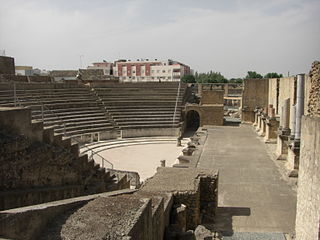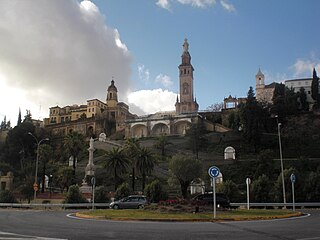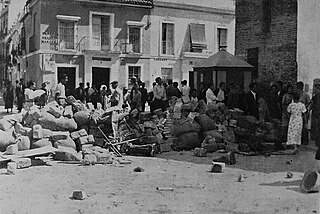
Seville is the capital and largest city of the Spanish autonomous community of Andalusia and the province of Seville. It is situated on the lower reaches of the River Guadalquivir, in the southwest of the Iberian Peninsula.

The Guadalquivir is the fifth-longest river in the Iberian Peninsula and the second-longest river with its entire length in Spain. The Guadalquivir is the only major navigable river in Spain. Currently it is navigable from Seville to the Gulf of Cádiz, but in Roman times it was navigable from Córdoba.

Écija is a city and municipality of Spain belonging to the province of Seville, in the autonomous community of Andalusia. It is in the countryside, 85 km east of the city of Seville. According to the 2008 census, Écija had a total population of 40,100 inhabitants, ranking as the fifth most populous municipality in the province. The river Genil, the main tributary of the river Guadalquivir, runs through the city.

Seville has been one of the most important cities in the Iberian Peninsula since ancient times; the first settlers of the site have been identified with the Tartessian culture. The destruction of their settlement is attributed to the Carthaginians, giving way to the emergence of the Roman city of Hispalis, built very near the Roman colony of Itálica, which was only 9 km northwest of present-day Seville. Itálica, the birthplace of the Roman emperors Trajan and Hadrian, was founded in 206–205 BC. Itálica is well preserved and gives an impression of how Hispalis may have looked in the later Roman period. Its ruins are now an important tourist attraction. Under the rule of the Visigothic Kingdom, Hispalis housed the royal court on some occasions.

The Torre del Oro is a dodecagonal military watchtower in Seville, southern Spain. It was erected by the Almohad Caliphate in order to control access to Seville via the Guadalquivir river.

Puertollano is a municipality of Spain located in the province of Ciudad Real, Castile-La Mancha. The city has a population of 45,539 (2022). Contrasting to the largely rural character of the region, Puertollano stands out for the importance of industry, with a past linked to industrial and mining activities. It lies on the AVE high-speed train line linking Madrid and Seville.

Alcalá de Guadaíra is a town located approximately 17 km southeast of Seville, Spain; in recent years the expansion of Seville has meant that Alcalá has become a suburb of that city. Alcalá used to be known as Alcalá de los Panaderos because it provided most of Seville's bread. The town is located on the banks of the Guadaíra River, and watermills built during the Moorish period of Spain can still be found in the area.

Triana is a neighbourhood and administrative district on the west bank of the Guadalquivir River in the city of Seville, Spain. Like other neighbourhoods that were historically separated from the main city, it was known as an arrabal. Triana is located on a peninsula between two branches of the Guadalquivir, narrowly linked to the mainland in the north. Two other districts are also usually included in this area, Los Remedios to the south and La Cartuja to the north.

Los Remedios is a district of Seville, the regional capital of Andalusia, Spain. It is located on the Isla de La Cartuja, south of the district of Triana, between two forks of the Guadalquivir river. It is linked by bridge to the city centre and the districts of Distrito Sur and Bellavista-La Palmera. From the western side of the island, it is linked by road bridge to the city of San Juan de Aznalfarache and shares a boundary in the Guadalquivir with the city of Gelves. The southern tip of La Cartuja is opposite the municipality of Dos Hermanas.

The Casco Antiguo is the city centre district of Seville, the capital of the Spanish region of Andalusia. The Casco Antiguo comprises Seville's old town, which lies on the east bank of the Guadalquivir river. It borders the districts of Macarena to the north, Nervión and San Pablo-Santa Justa to the east, and the Distrito Sur to the south. Bridges across the Guadalquivir link the Casco Antiguo to Los Remedios, Triana and La Cartuja.
La Algaba is a Spanish municipality in the province of Seville, Andalusia, with a population of around 16,000. It is part of the region of La Vega and is located 11 km from the province's capital, Seville. The town dates back to the Byzantine Empire and has many historical artifacts and significant churches.

San Juan de Aznalfarache is a city located in the province of Seville, Spain. According to the 2006 census (INE), the city has a population of 20,121 inhabitants.

Manuel García y Rodríguez was a Spanish costumbrista and landscape painter, who also painted Orientalist scenes.

The Instituto Nacional de Colonización y Desarrollo Rural was the administrative entity that was established by the Spanish State in October 1939, shortly after the end of the Spanish Civil War, in order to repopulate certain areas of Spain. This entity depended from the Ministry of Agriculture and it sought to alleviate the effects of the devastation caused by the three years of civil war.

The July 1936 military uprising in Seville was part of a nationwide coup d'état in Spain, launched by part of the Spanish army. It was supposed to topple local Republican administrations in Seville and western Andalusia. The uprising commenced on 18 July 1936, led by general Gonzalo Queipo de Llano. The rebels overpowered regional military command and some key units without a shot being fired, but were offered resistance by Guardia de Asalto, subordinated to the civil governor José María Varela; it was overcome later in the day. The days of 19–22 July were mostly about seizing the districts of Triana, Macarena and San Julián; they were controlled by revolutionary trade unions and radical left-wing militias. On 23 July Queipo was fully in control. The successful coup in Seville proved of vital importance for the rebels nationwide; the insurgent pocket in south-western Andalusia enabled the shift of the Army of Africa to the peninsula, and then its rapid advance towards Madrid.

Seville, the capital of the region of Andalusia in Spain, has 11 districts, further divided into 108 neighbourhoods.
There are numerous sights and landmarks of Seville, Spain. The most important sights are the Alcázar, the Seville Cathedral, and the Archivo General de Indias, which are UNESCO World Heritage Sites.

The historic centre of Córdoba, Spain is one of the largest of its kind in Europe. In 1984, UNESCO registered the Mosque–Cathedral of Córdoba as a World Heritage Site. A decade later, it expanded the inscription to include much of the old town. The historic centre has a wealth of monuments preserving large traces of Roman, Islamic, and Christian times.

Monastery of San Clemente is a Cistercian monastery with the Bien de Interés Cultural designation in the Spanish city of Seville. Architecturally, it is a heterogeneous set of buildings, built in different times and styles, from the 16th to the 17th century.

The San Telmo Bridge is a concrete bridge located in Seville, Spain. It was inaugurated in 1931, and crosses the Guadalquivir.























